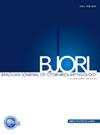Comparative analysis between the gold standard titration method and a mathematical formula to predict CPAP pressure
IF 1.7
4区 医学
Q2 OTORHINOLARYNGOLOGY
引用次数: 0
Abstract
Objective
One lower-cost alternative to either manual or APAP titration is predicting therapeutic pressure by using mathematical formulas. This study aimed to determine whether the Miljeteig and Hoffstein predictor formula was equivalent to the pressure established by manual titration in a sleep laboratory in patients using nasal or pillow masks.
Methods
The authors analyzed all CPAP titration polysomnography studies in adult patients for three consecutive months (May 20th to August 19th, 2018) in a sleep-disorders clinic. CPAP pressures were manually titrated over the night. Anthropometric data (age, sex, Body Mass Index [BMI], Neck [NC] and waist circumference) and polysomnographic data were documented. We tested Miljeteig and Hoffstein model formula-predicted CPAP (Hpred) accuracy in our patients, comparing formula results to our manual titration; Hpred = (0.16 BMI) + (0.13 NC) + (0.04 AHI) - 5.12.
Results
Nasal masks were used in 55% of our patients (n = 86) and pillow masks in 45% (n = 71). There was no difference between groups for age, body mass index, neck circumference, waist circumference, gender, baseline apnea-hypopnea index, CPAP pressure and residual AHI during titration polysomnography. The mean difference obtained between CPAP pressure and Hpred formula was 2.4 cm H2O. The CPAP pressure means during titration was 2.4 cm H2O higher than pressure obtained by a formula for pillow group and 2.3 for the nasal group.
Conclusions
In most patients, formula underestimated the CPAP pressure obtained during titration for both nasal and pillow masks. Even though the pressure is underestimated, this approach could help to define minimum and maximum titration pressure using APAP in patients with OSA until the optimal pressure can be determined in the sleep laboratory if necessary.
Level of evidence
Level 3.
金标准滴定法与数学公式预测CPAP压力的比较分析
目的利用数学公式预测治疗压力是人工或APAP滴定的一种低成本替代方法。本研究旨在确定Miljeteig和Hoffstein预测公式是否等同于在睡眠实验室中使用鼻罩或枕罩的患者通过手动滴定确定的压力。方法分析某睡眠障碍门诊连续3个月(2018年5月20日至8月19日)成人患者的所有CPAP滴定多导睡眠图研究。夜间手动滴定CPAP压力。记录了人体测量数据(年龄、性别、身体质量指数(BMI)、颈部(NC)和腰围)和多导睡眠图数据。我们在患者中测试了Miljeteig和Hoffstein模型公式预测CPAP (Hpred)的准确性,并将公式结果与我们的手动滴定进行比较;Hpred = (0.16 BMI) + (0.13 NC) + (0.04 AHI) - 5.12。结果86例(55%)患者使用鼻口罩,71例(45%)患者使用枕头口罩。各组间年龄、体重指数、颈围、腰围、性别、基线呼吸暂停低通气指数、CPAP压和滴定多导睡眠图时残留AHI均无差异。CPAP压力与Hpred公式的平均差值为2.4 cm H2O。滴定时CPAP压力均值比按公式计算的压力高2.4 cm H2O,枕头组高2.3 cm H2O。结论在大多数患者中,处方均低估了鼻罩和枕罩滴定时获得的CPAP压力。尽管压力被低估了,但这种方法可以帮助确定OSA患者使用APAP滴定的最小和最大压力,直到必要时在睡眠实验室确定最佳压力。证据等级:3级。
本文章由计算机程序翻译,如有差异,请以英文原文为准。
求助全文
约1分钟内获得全文
求助全文
来源期刊

Brazilian Journal of Otorhinolaryngology
OTORHINOLARYNGOLOGY-
CiteScore
3.00
自引率
0.00%
发文量
205
审稿时长
4-8 weeks
期刊介绍:
Brazilian Journal of Otorhinolaryngology publishes original contributions in otolaryngology and the associated areas (cranio-maxillo-facial surgery and phoniatrics). The aim of this journal is the national and international divulgation of the scientific production interesting to the otolaryngology, as well as the discussion, in editorials, of subjects of scientific, academic and professional relevance.
The Brazilian Journal of Otorhinolaryngology is born from the Revista Brasileira de Otorrinolaringologia, of which it is the English version, created and indexed by MEDLINE in 2005. It is the official scientific publication of the Brazilian Association of Otolaryngology and Cervicofacial Surgery. Its abbreviated title is Braz J Otorhinolaryngol., which should be used in bibliographies, footnotes and bibliographical references and strips.
 求助内容:
求助内容: 应助结果提醒方式:
应助结果提醒方式:


